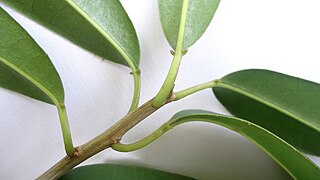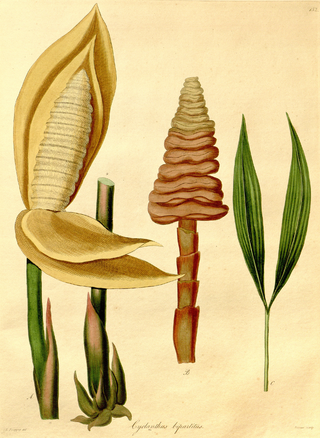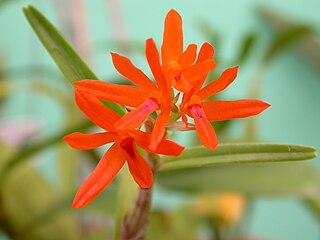
Sapium is a genus of flowering plants in the family Euphorbiaceae. It is widespread across most of Latin America and the West Indies. Many Old World species were formerly included in the genus, but recent authors have redistributed all the Old World species into other genera.

Eduard Friedrich Poeppig was a German botanist, zoologist and explorer.

Tetrorchidium is a genus of flowering plants in the family Euphorbiaceae first described in 1841. It is native to tropical portions of Africa and the Western Hemisphere.

Caryocar is a genus of flowering plants, in the South American family Caryocaraceae described as a genus by Linnaeus in 1771. It is native primarily to South America with a few species extending into Central America and the West Indies.

Dalechampia dioscoreifolia is a species of plant in the family Euphorbiaceae first described in 1841. It is native to Central America and northern and western South America.

Cyclanthus a genus of plants in the family Cyclanthaceae, first described as a genus in 1824. It is native to tropical Latin America and the West Indies. It consists of large, palm-like monocots.

Cyclanthus bipartitus a species of plant in the family Cyclanthaceae, first described as a genus in 1824. It is native to southern Mexico, Central America, Trinidad, Windward Islands, northern South America.

Comparettia, abbreviated Comp in the horticultural trade, is a genus of orchids. It consists about 50-70 species, native to tropical America. They occur in Mexico, Central America, the West Indies, and in northern South America as far south as Brazil and Bolivia, although they are particularly common in the Andes. The genus has grown markedly in recent years due to many species being transferred from other genera.

Scaphyglottis is a genus of orchids native to Mexico, Central America, northern South America and parts of the Caribbean. The current concept of this genus is the result of combining several genera which have been described at various times. The concept is characterized by the growth habit: not only are new pseudobulbs added at the base of the old ones, but new pseudobulbs also grow at the apices of the old ones. Many species are quite similar and difficult to distinguish, but some are clearly distinct. A few have showy colors. The genus comprises nearly 70 species.
Siapaea is a genus of plants in the tribe Eupatorieae within the family Asteraceae.
Thrasya is a genus of Neotropical plants in the grass family.

Trichospira is a genus of flowering plants in the tribe Vernonieae within the family Asteraceae.

Paranephelius is a genus of South American plants in the tribe Liabeae within the family Asteraceae.

Eduard Fenzl was an Austrian botanist.

Schiekia is a genus of herbs in the family Haemodoraceae, first described as a genus in 1957. It contains only one recognized species, Schiekia orinocensis, native to South America. This plant grasped the minds of many scientists who tried fruitlessly to discover its purpose in the natural order.
Oriastrum is a genus of plants in the sunflower family, found only in the Republic of Chile in South America.

Qualea parviflora, known as pau-terra in Portuguese, is a deciduous tree indigenous to Bolivia, Brazil, and Paraguay. The tree favors dry climates like the tropical savanna of the cerrado.
Cupania cinerea is a plant species in the family Sapindaceae. It was described as a new species in 1843 by German botanist Eduard Friedrich Poeppig. The plant is native to South America and Central America.












